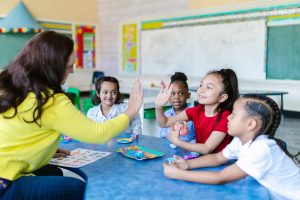3 Intervention for Language Disorders Within Dialects
For children speaking AAE, dialect density has a negative impact on reading and writing, such that children who use a greater proportion of dialectal features evidence lower performance and slower growth on measures of reading and writing (Fitton et al., 2021; Puranik et al., 2019; Washington et al., 2018). Of note, reading has a facilitative effect on writing, even in children with high dialect density (Puranik et al.). Density of AAE-specific forms does not significantly predict scores on standardized literacy measures (Fitton et al., 2021). These findings suggest that it may not be necessary to address spoken dialect directly. Targeting oral language and reading and writing skills may facilitate academic success for speakers of NMAE (Fitton et al., 2021; Washington et al., 2018). Children with poor reading skills who have high density of AAE features and weaker oral language skills may experience particular difficulty shifting from their home dialect to the dialect of the classroom, which may adversely impact their academic success. Working on oral language skills earlier rather than later is important to facilitate academic success in speakers of NMAE who demonstrate language deficits (Washington et al.)
Russell and Shiffler (2020) described a promising intervention delivered to first-grade African American boys in an urban charter school. Their intervention consisted of 30-minute weekly whole-class sessions focusing on phoneme-grapheme correspondence. They introduced words with final consonant clusters that were dialect sensitive, such as plan/plant, via interactive storybook reading. Activities included segmenting, blending, and manipulating the sounds in the words using blank tiles. A meta-cognitive aspect was included in the intervention, in which the interventionists explicitly modeled phoneme-grapheme manipulation. The boys increasingly negotiated the differences between MAE and AAE as the year progressed, possibly due to the meta-cognitive component of the intervention.
Husband and Kang (2020) identified practices to promote literacy specifically in Black boys in grades k-12. Use of culturally relevant texts, that is, texts related to their own world experiences, can benefit decoding and fluency when included in the broader context of the classroom or school. Providing choices in selection of reading material and encouraging reading as a collaborative, social process promotes increased literacy. Teaching Black boys how to organize information and relate it to their background knowledge helps them more deeply understand expository, or informational, texts. Phonemic awareness instruction is critical for this group of learners, just as it is for other learners.
Another effective practice to promoting literacy in Black students is using a critical literacy approach. A critical literacy approach involves teaching children to
1) disrupt the commonplace, that is, challenge the status quo, include controversial topics in order to challenge commonly held views;
2) consider multiple perspectives, particularly those of historically marginalized groups;
3) focus on sociopolitical issues; and
4) taking action and promoting social justice
Washington and Seidenberg (2021) offer six recommendations for teaching reading to children who speak AAE:
- Help teachers learn about dialect variation.
- Help children learn more about the world prior to beginning school via exposure to language through conversations and reading with adults.
- Use practices that are effective with speakers of AAE. Recognize that phonological and phonemic awareness and phonics activities may function differently for children who speak AAE. due to phonological differences between AAE and GAE.
- Allow sufficient time to complete tasks.
- Provide constructive responses to use of AAE in the classroom. Do not correct the child, but do model the MAE form. Teaching differences between AAE and MAE in whole-class lessons can be productive in helping children understand differences between the two language varieties.
- Understand the impact of being bidialectal on language understanding and use.
In short, work with children speaking NMAE dialects needs to demonstrate respect for the “home language,” while systematically exposing the children to the “language of school.” This must be done in a way that celebrates the NMAE dialect while facilitating success in academic settings. SLPs must be advocates for promoting the celebration of NMAE dialects and must teach others the value of being bidalectal.

References
Fitton, L., Johnson, L., Wood, C., Schatschneider, C., & Hart, S. (2021). Language variation in the writing of African American Students: Factors predicting reading achievement. American Journal of Speech-Language Pathology, 30, 2653-2867.
Husband, T., & Kang, G. (2020). Identifying promising literacy practices for black males in P-12 classrooms: An integrative review. Journal of Language and Literacy Education, 16(1), n1.
Puranik, C., Branum‐Martin, L., & Washington, J. A. (2020). The relation between dialect density and the codevelopment of writing and reading in African American children. Child Development, 91(4), e866-e882.
Russell, J., & Drake Shiffler, M. (2019). How does a metalinguistic phonological intervention impact the reading achievement and language of African American boys?. Reading & Writing Quarterly, 35(1), 4-18.
Washington, J., Branum-Martin, L., Sun, C., & Lee-James, R. (2018). The impact of dialect density on the growth of language and reading in African American children. Language, Speech, and Hearing Services in Schools, 49, 232-247. https://doi.org/10.1044/2018_LSHSS-17-0063
Washington, J., & Seidenberg, M. (2021). Teaching reading to African American Children: When home and school language differ. American Educator, Summer 2021. Retrieved from https://www.aft.org/ae/summer2021/washington_seidenberg.
ability to perceive and manipulate the individual sounds in words
